In March 2023, millions of sensitive Siemens Metaverse corporate data were exposed due to old unpatched vulnerabilities. Is there a data breach in your organization’s future, too? Find it out with OSINT tools — the digital “crystal balls” that’ll help you predict your organization’s security future by harnessing the power of publicly available data.
Between March 2021 and March 2022, organizations took an average of 207 days to identify information leaks. Are there ways they could have noticed sooner or even taken steps to prevent them?
Probably, yes. How? Using the same weapon often utilized by attackers: publicly available data. But how can organizations gather exactly the information they need to protect themselves from attackers among the plethora of online data available? This is where OSINT tools come into play for improving your cyber defenses.
This article will explore the wonderful world of open-source intelligence tools (OSINT). It’s a place where massive amounts of unorganized, raw data are transformed into the most useful information. Explore our top five best OSINT tools for research and pentesting to learn
- What OSINT tools are,
- How they work, and
- Why they’re useful to businesses, their employees, and pentesters alike.
Fasten your seat belts and get ready to take a ride!
What Are the 5 Best OSINT Tools for Penetration Testing and Research?
Every time I hear the word “information,” the dialogue of the opening sequence of the 1967 British TV series “The Prisoner” comes to mind:
”Number Six: Where am I?
Number Two: In the village.
Six: What do you want?
Two: Information.
Six: Whose side are you on?
Two: That would be telling. We want information…information… information!!
Six: You won’t get it!
Two: By hook or by crook, we will.”
Information has always been valuable, for one reason or another, to everyone. Governments, organizations, individuals — you name it. The value of data is growing steadily in today’s digital age. So, too, is the demand for open-source intelligence tools, which Global Intelligence Insights forecasts to reach a market value of $60 billion in 2032. Why? Because in a world where 66% of the world’s population has internet access, there’s no need to gather information “by hook or by crook” anymore.
All you need now is one or more good OSINT tools, like the five we’ve summarized in the table below.
| 5 Best OSINT Tools | Top 2 Features | Compatible Operating Systems | Cost |
| Nmap | Check the security of firewalls. Find and test network vulnerabilities and flaws. | Windows macOS Linux Many other OS (source code) | Free. |
| Maltego | Detect hidden connections. Pinpoint specific patterns. | Windows macOS Linux | Free and paid versions are available. |
| WebShag | Identify insecure connections. Find unprotected files. | Windows macOS Linux | Free. |
| TheHarvester | Pentest your own or a third-party network. rDNS lookups. | Windows macOS Linux | Free. |
| Recon-ng | Identify error-based SQL injections. Locate sensitive files like robot.txt. | Windows macOS Linux | Free. |
Interested in digging deeper and becoming the next digital Sherlock Holmes? Read on to explore the what, the how, and the why of the five best OSINT tools we’ve identified for you.
What Is Open Source Intelligence and What Is It Used For?
Have you ever wondered how governments, journalists, and law enforcement agencies manage to acquire the most hidden and secretive information, identify patterns, and find the needles in the haystack? With the support of open source intelligence tools.
But what are these resources? OSINT tools include all web apps and software that enable virtually anyone to harvest and analyze any kind of data publicly available on the internet. Basically, they’re reconnaissance tools. The outcome can then be used to improve decision-making and build strategies.
Hold on. We’ve just said, “any kind of data,” right? Yup, that’s correct. OSINT tools can harvest any content available in the digital world, including:
- Social media posts,
- News,
- Photos,
- Documents,
- Academic papers,
- Geolocation info,
- Personal data, and
- Technical data.
This sounds like the perfect playground for hackers, governments, and intelligence agencies. It’s a gold mine, for sure. Is it legal? Yup, OSINT tools are perfectly legal, as they deal with information that’s already accessible to the public. It’s what they’re used for that makes the difference.
In fact, they can be utilized for several innocent activities such as:
- Finding information not indexed by Google or other search engines. Couldn’t find the information you were looking for to complete your research? Google Dorks is an advanced search method that’ll help you locate what you can’t find with regular searches. It’s so powerful that it’s often used by pentesters, and bug bounty program participants to discover websites’ security holes.
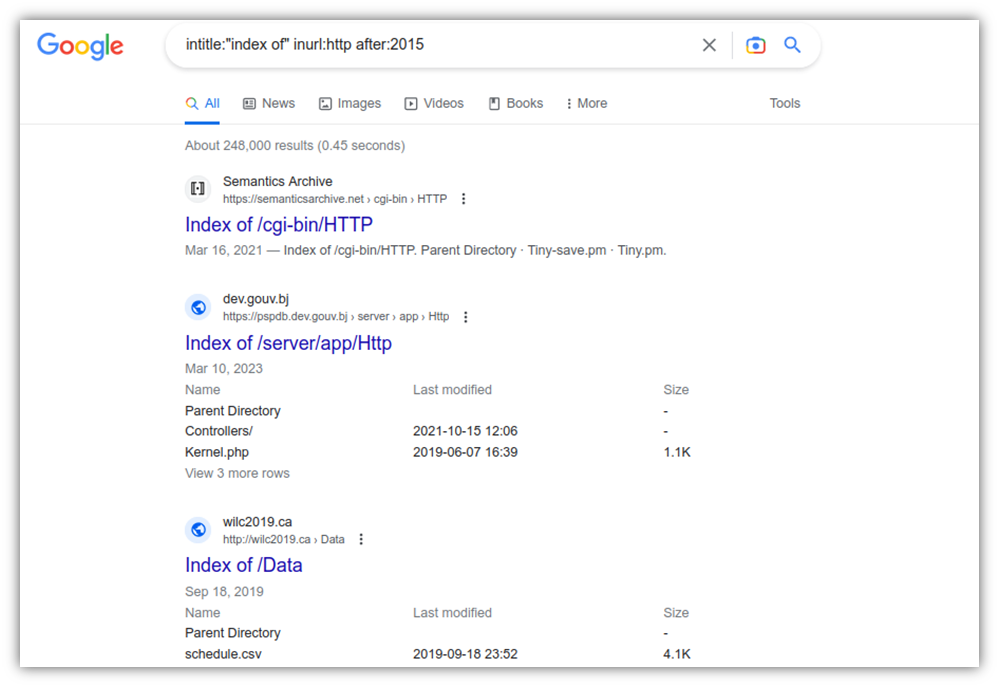
- Discover if and/or where your images appear online or find copyright violations. TinEye is a reverse image search OSINT tool considered an excellent alternative to Google Images, above all if you’re looking to keep your searches private and secure. It has a huge database with more than 40 million images. Unlike the completely free Google Images, TinEye offers a browser extension on top of its free version and a paid fully hosted API to keep your searches protected and confidential through encryption.
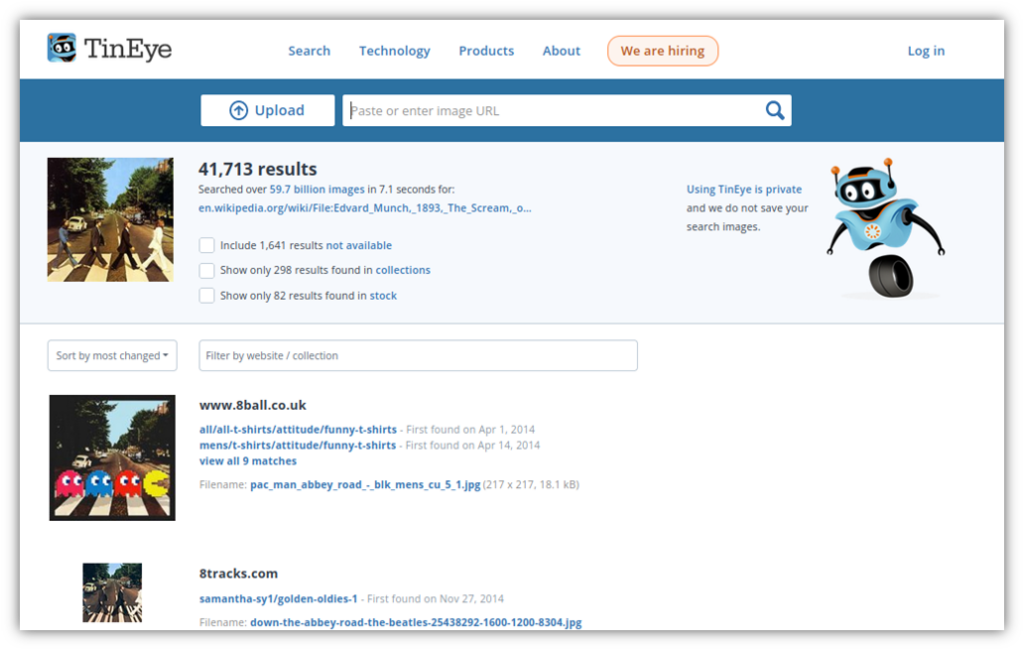
- Find a specific username across different websites and social media. Interested in hunting usernames and accounts? You can do that with OSINT tools like WhatsMyName. With an easy-to-use web interface, this OSINT tool enables you to search for specific usernames across websites. From the results, you can then build a pretty good profile of the user in question (e.g., discover which websites they use and their preferences).

But there’s the other side of the coin, too. OSINT tools are among cybercriminals’ favorite weapons to spot flaws and juicy information they can exploit. In fact, the Federal Bureau of Investigation (FBI), the Department of Homeland Security (DHS), and the National Counterterrorism Center (NCTC) published a warning in 2014 about attackers using Google Dorks to identify vulnerabilities and sensitive data on the internet.
Cybersecurity experts know this. That’s why OSINT tools are considered a staple in every pentester/ethical hacker and cybersecurity professional’s toolkits.
They are powerful tools that, when used for the right cause, can allow organizations to track hackers’ activities and identify vulnerabilities in a fraction of the time (more on this in a moment). But, how? And is this the only reason why they’re so vital? This is what we’re going to explore next.
Why Are Open Source Intelligence Tools Important In Cybersecurity?
Did you know that IDC’s Global DataSphere forecasts the amount of data created on an annual basis will have a compound annual growth rate (CAGR) of 21.2% and surpass 221,000 exabytes by 2026? What is an exabyte? That’s 1,000 pentabytes, or roughly the equivalent of 1,000,000,000,000,000,000 bytes.
The use of OSINT tools can be a valid, low-cost investment for every organization’s cyber security strategy and an effective option for smaller businesses with limited budgets. With OSINT, individuals and enterprises can tap into an endless source of free information to create ordo ab chaos (i.e., order from chaos) by extracting and analyzing data to facilitate:
Penetration Testing Activities
In 2022, 88% of the companies interviewed by Pentera admitted to having been a victim of a cyber security incident during the previous two years. OSINT tools can help pentesters quickly unearth hidden vulnerabilities and clues that otherwise would go unnoticed.
Once the potential exploits are found, the appropriate fixes can be applied before the attackers have a chance to strike and risk compromising the security of an organization and/or application.
Data Breach Prevention
With the average cost of a data breach set to exceed $5 million in 2023, 70% of businesses surveyed in 2022 have already invested in proactive vulnerability assessment software. Pentesting, run at least once a year by 87% of enterprises, and with the support of OSINT tools, is one of them.
Want to follow the trend? Open-source intelligence tools can transform your cyber security strategy from reactive to proactive. How? By helping you:
- Identifying any critical information about your organization made public on the internet (e.g., social media posts, reports), and
- Sniffing out flaws in your systems that could potentially lead to a data breach.
White Hat Hacking
In January 2023, a group of white hat hackers successfully broke into the systems of luxury car manufacturers (giants like BMW, Ferrari, Jaguar, Porsche, and Rolls-Royce) and identified a variety of flaws.
How do ethical hacker wizards help enterprises detect vulnerabilities to minimize the risk of catastrophic attacks? By penetrating their systems, network, and software using the same methods as cybercriminals, including the best OSINT tools.
Monitoring of Chatter Trends
In the past, druids, gypsies, and magicians used crystal balls to scry into the future. Wouldn’t it be marvelous if you could have something similar to predict ransomware and other malicious attacks before they happen?
Oh, wait! OSINT tools can help you do that, too! How? By monitoring online chats and discussions, for example. This was demonstrated by a 2018 research and by an interesting investigation by Rapid7’s Threat Intelligence team regarding Log4shell discussions in hacker’s chatters.
And it doesn’t stop here. OSINT tools are so versatile that they aren’t only utilized to enhance digital and physical security. They’re also very useful for background checks, fraud detection, mapping, and all sorts of research, in all fields and industries.
How Do Open Source Intelligence Tools Work?
Have you ever watched the British mystery crime series “Sherlock?” In the series, a modern Sherlock Holmes solves various mysteries by visualizing, selecting, and connecting key information that otherwise would go unnoticed by law enforcement members.
OSINT tools follow more or less the same process. Let’s say you want to check if any of your employees have inadvertently posted sensitive information about your organization on social media. Once you’ve selected the best OSINT tool for the job:
- Decide from which sources you’ll get the data you’re looking for (e.g., LinkedIn, Facebook, TikTok).
- Use the OSINT tool to gather information from the chosen social media.
- The tool will then process the data, piecing it together and identifying those that may be useful to achieve your goal. Just like a puzzle.
- Now that you have a clearer picture and the information you need, you can analyze the results.
- Deliver the outcome of your analysis to the stakeholders for action.
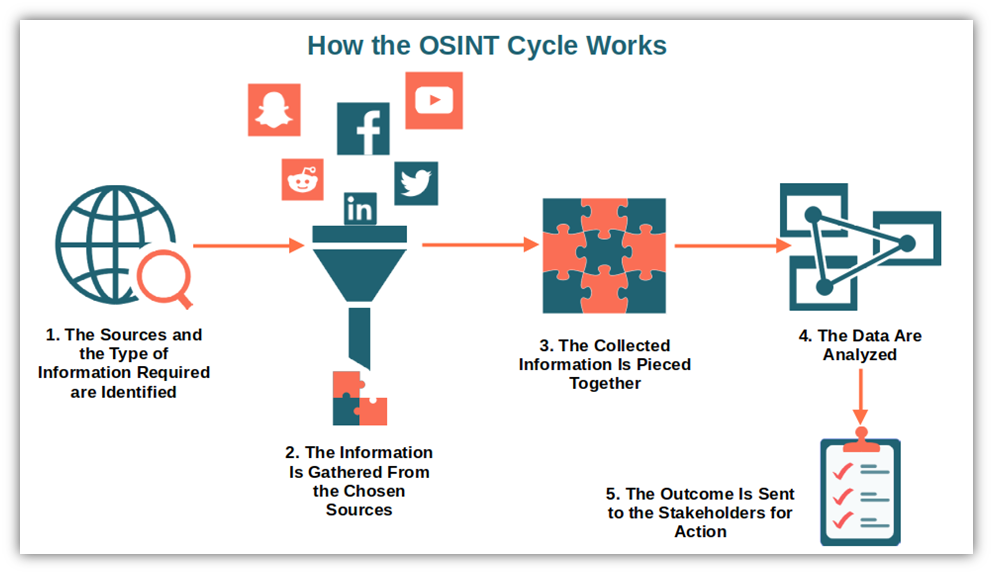
Cool, huh? I bet Sherlock Holmes would have loved playing with such powerful tools.
With the what, how, and why of OSINT tools now done and dusted, it’s time to get into the nitty-gritty. Let’s explore what have to offer the five best OSINT tools for research and penetration testing we’ve listed at the beginning of our adventure.
A Breakdown of the Top 5 Best OSINT Tools for Pentesting and Research
Pentesting is an essential part of every organization’s security strategy and, depending on the size of the business, it’s also officially required for compliance with the Payment Card Industry Data Security Standard (PCI DSS).
But viewing a company from a hacker’s perspective and simulating cyber attacks takes time, skills, and the right tools. We’ve selected five among all the OSINT tools out there that we believe could make pentesters’ and researchers’ lives and work easier. Let’s have a look at them one by one.
1. Network Mapper (Nmap)

First released in 1997, Nmap has become a powerful network scanner considered the top of the range for:
- Ports scanning. To help you identify open ports or verify if they’re behind a firewall.
- Vulnerability assessments. Find vulnerabilities and flaws in your network, bring to light new servers, and simulate exploitation.
- Network mapping. Useful for rooting out misconfigurations, inventory, asset management, and maintenance.
Nmap is extensively used by cybersecurity professionals, network administrators, cybercriminals, and… Hollywood movies. Yup, you read it right. It’s so popular that it has been even utilized in several hacking scenes in movies like “The Matrix Reloaded,” “Snowden,” “Elysium,” and “Die Hard 4,” just to name a few.
Want to fight the bad guys like Neo or Trinity did in the Matrix series? Give it a try using Nmap.
Setting it up is an absolute piece of cake. Nmap works with all major operating systems, it’s easy to customize, and its code source is available in multiple languages. To make things even easier, the basic features also work out of the box. You don’t feel comfortable with using the terminal or you’re a newbie? No worries. It also offers an intuitive graphical user interface (GUI) called Zenmap that works with multiple platforms.

| Nmap’s Key Features | Typical Uses | Licensing |
| Host discovery. Helps you identify hosts in a network and find open ports. | Check the security of firewalls. | Free |
| Port scanning. Lists the open ports on target hosts. | Identify incorrectly open ports. | |
| Version detection. Queries network services on remote devices to acquire application name and version. | Find out new servers included in the network. | |
| User datagram protocol (UDP) scans. These help to reveal trojan horses and hidden remote copy protocol (RCP) services (i.e., insecure method vulnerable to man-in-the-middle attacks used to remotely copy files or directories from one system to another). | Find and test network vulnerabilities and flaws. |
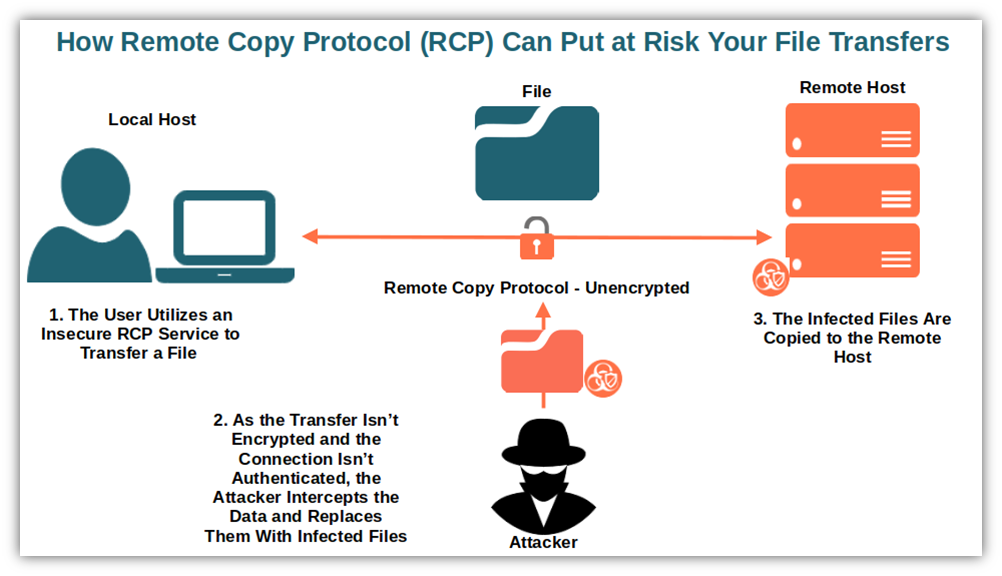
Fascinated by Nmap? Dig deeper by watching an exhaustive series of three tutorial videos for beginners by HackerSploit.
2. Maltego
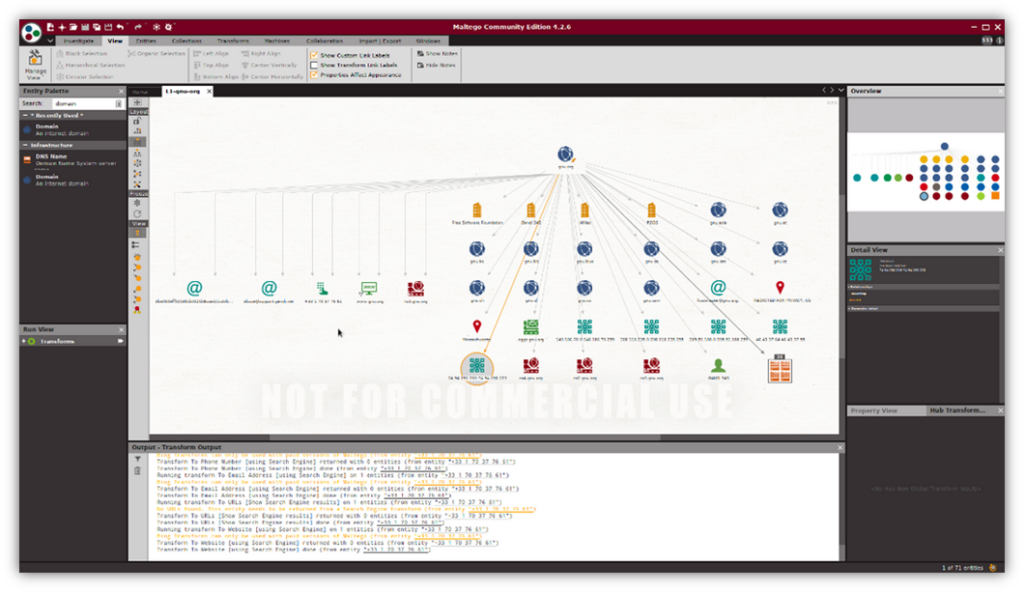
As one of the most known OSINT tools, Maltego is used by security professionals, law enforcement agencies, private investigators, and researchers to:
- Mine data from multiple sources.
- Merge and automatically combine the harvested information into a graphic.
- Map the discovered data by choosing from different layouts to help you identify patterns.
- Export the outcome for further use.
The platform allows users to find and visualize relationships between individuals, organizations, groups, websites, domains, internet infrastructure, and other digital assets. Developed by Paterva, it’s included in the Linux Kali operating system. Want to find and track attackers’ footprints in your internal network and on the internet? This is the tool for you.
Maltego is considered flexible and easy to use thanks to its intuitive GUI. Among its features, this OSINT tool offers:
- Free access to more than 58 data integration from over 38 data partners (e.g., DNS records, social networking services, APIs, search engines) in the Maltego Transform Hub, and
- Connection of up to one million entities in a single graphic.
| Maltego’s Key Features | Typical Uses | Licensing |
| Automatic entities detection. Uses regex pattern matches to automatically detect entity types. | Identify threats. | Free and paid versions are available. |
| Tools integration. Connects OSINT tools, commercial tools, and its own data sources to get a larger information pool. | Detect hidden connections between different data and sources. | |
| Graphic analysis. Transforms the mined data into graphics. | Pinpoint specific patterns. | |
| High customization. Offers customizable data queries and link analysis. | Pentesting for port hacking. |
Uncover everything you need to know to get started with Maltego by checking the official tutorial for beginners.
3. WebShag
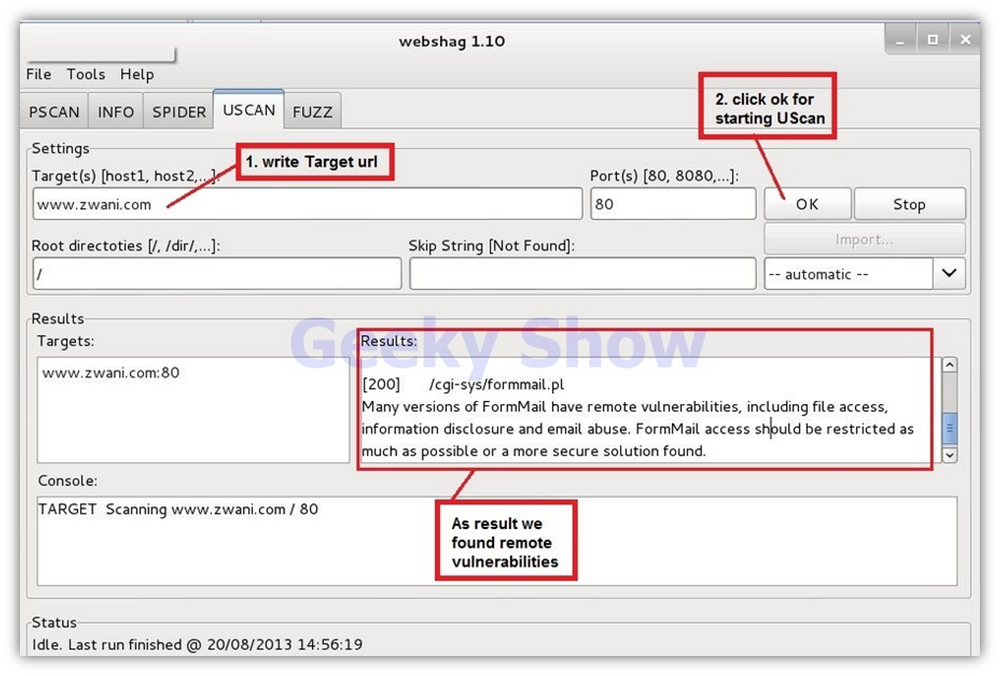
Do you use SSL/TLS checkers to verify if your website’s SSL/TLS certificate is installed correctly and properly recognized by the major browsers? WebShag takes this kind of security check to the next level.
WebShag is another OSINT tool that’s included in Kali Linux and is available for Windows is an evergreen resource for server auditing and pentesting. Written in Python and offering a command line and GUI interface, it enables security experts to:
- Verify if websites have the hypertext transfer protocol secure (HTTPS) implemented.
- Retrieve the list of domains hosted on a server.
- Perform “fuzz scanning” to find hidden files and pages.
Not bad for an old-timer, huh? With Radware reporting attacks on web applications and APIs increasing by a whopping 128% in 2022, ensuring that all data transmitted to and from your web servers is encrypted and secured by a TLS certificate has become paramount.
In fact, HTTPS and TLS certificates can protect your data from snooping during transmission (e.g., man-in-the-middle attacks). That’s why they’re such important elements in pentesting.

Want to be able to pentest your organization’s remote servers without getting blocked or rate-limited by your firewall’s rules? This excellent OSINT tool offers intelligent ID evasion features to allow you to keep on pentesting your servers without being banned by the system.
| WebShag’s Key Features | Typical Uses | Licensing |
| HTTP and HTTPS scanning. Checks for insecure/unencrypted connections. | Identify insecure connections. | Free. |
| Spider scanning. Gives you a list of files, email addresses, and URL links found on a website. | Find files without .htaccess protection. | |
| Fuzz scanning. Locate hidden files and pages. | Spot hidden malicious files. | |
| Website Crawling. Gets you all the data you need in a structured manner. |
4. TheHarvester

Worried about your organization’s valuable sensitive data being scattered all over the internet? This tool, part of Kali Linux’s collection as well and also developed in Python, is probably one of the best OSINT tools to find:
- Email addresses,
- IP addresses,
- Organization’s subdomains, and
- Virtual hosts.
In 2022, for every vendor target of a data breach, 4.73 companies were affected. Want to avoid having your organization’s critical data exposed in one of your vendor’s data breaches? TheHarvester can help you ensure you know exactly who has that information and if it’s protected enough against attacks.
| TheHarvester’s Key Features | Typical Uses | Licensing |
| Expanded domain search. Allows you to search a domain in all sources available. | Pentest your own or a third-party network. | Free. |
| Screenshots. Takes screenshots of all subdomains found during a search. | Fetch data from several search engines (even lesser-known ones like DNSdumpster), PGP key servers, and social networks. | |
| Vulnerabilities scans. Lets you scans web applications for vulnerabilities and flaws. | Launch pentest for DNS brute force attacks (i.e., the attacker uses a list of legitimate-looking queries aiming to identify a website’s subdomains, hostnames, and DNS records to discover vulnerabilities). | |
| Third party modules. Supports additional modules installation with an API key (e.g., GitHub, Bing API). | rDNS lookups (i.e., determine the hostname linked to an IP address). | |
| Advanced search. Supports Shodan search (more on that in a minute) to spot open ports. |
Want to see TheHarvester in action? Check out this three-minute brief pentesting demo.
5. Recon-ng
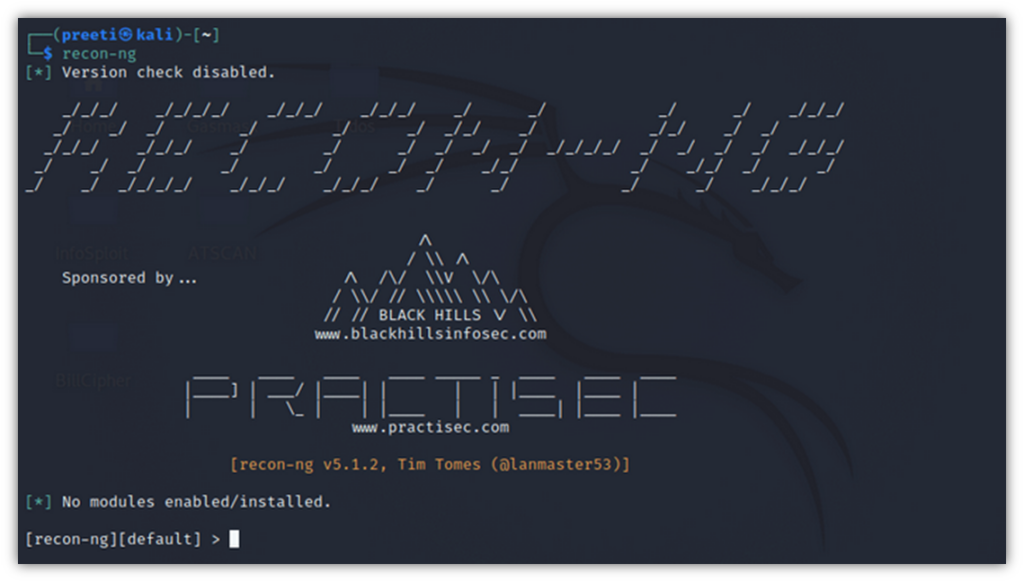
The name says it all. Recon-ng is another incredibly powerful OSINT tool framework that’s part of Kali Linux’s arsenal. It’s used to perform reconnaissance (i.e., gaining information) of remote targets.
Built with a modular architecture, that facilitates extension with additional modules, it:
- Automates time-consuming OSINT activities,
- Speeds up data harvesting,
- Stores all the crawled information into a database so that can be used to generate custom reports.
While some of its modules are focused on passively gathering information, it’s a great tool for assessing the vulnerability of applications and finding loopholes. This is extremely important for pentesters and software developers alike. Why? According to Veracode’s latest research, nearly 70% of applications have at least one security flaw within five years of deployment.
| Recon-ng’s Key Features | Typical Uses | Licensing |
| Application scanning. Works as a web application and website scanner. | Gather information about a target in preparation for pentesting. | Free. |
| IoT scanning. Can scan IoT devices (i.e., hardware connected to the internet collecting and exchanging data) using the Shodan search engine. | Identify error-based SQL injections (i.e., when the attacker injects a malicious query to get an SQL error that’ll reveal the structure of the database). | |
| Module marketplace. Includes several modules (e.g., GeoIP lookup, Banner grabbing, DNS lookup, and port scanning). | Locate sensitive files like robot.txt (i.e., a file containing a set of instructions for bots like web crawlers. It avoids web server overloading or private page indexing). | |
| Interface for common tasks. Supports additional features like database interaction, web requests, and API key management. | Find out the content management systems (CMS) a web application uses. | |
| Plug-ins. Includes community-built plug-ins. | Collect employees, domains, and network data. |
That’s it. This was our selection of the five best OSINT tools for research and penetration testing. Of course, these are only a small portion of the plethora of OSINT tools available out there. Hungry for more OSINT tools? Check out GitHub’s OSINT comprehensive list.
Did you know that the U.S. Central Intelligence Agency (CIA)’s Center for the Studies of Intelligence website features, among its publications, compelling free research about OSINT tools “Sailing the Sea of OSINT in the Information Age”? Speaking about the CIA, why don’t we have a quick look at the cybercriminals’ quintessential OSINT tool before we wrap up?
Bonus: Shodan, the Hackers’ Search Engine
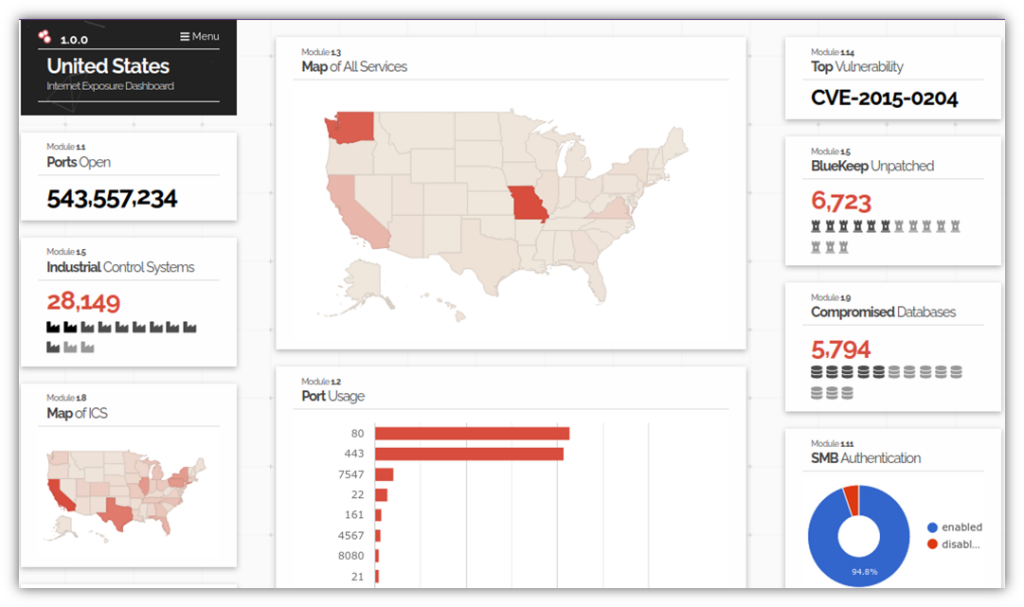
Image source: Shodan’s Internet Exposure Observatory map. The screenshot shows an example of one of the myriads of maps, searches, and analytics tools available in Shodan. This one in particular shows how an OSINT tool can give you an overall view of internet vulnerabilities in the U.S.
In our article, we’ve already mentioned Shodan a couple of times as a feature included in a few OSINT tools. Considered by the bad guys a gold mine full of vulnerable and exposed assets, it deserves an honorable mention as a useful tool for the good guys.
This OSINT tool is a dedicated search engine on steroids that let you find intelligence about:
- Internet of Things (IoT like cameras, sensors),
- Operational technology (e.g., the industrial control systems used by manufacturing and power plants),
- Information contained in databases, and
- Default passwords.
It even works with video games to unearth global offensive game servers (e.g., Counter-Strike: Global Offensive [CS:GO]) hiding in corporate networks and their vulnerabilities.
| Shodan’s Key Features | Typical Uses | Licensing |
| Security based search. Works like Google but focuses on the IT security side of websites (e.g., secure shell [SSH], HTTP, public information). | Gather information about a target including its location, configuration, and TSL/SSL certificate data. | Paid. Starting from $69 per month. |
| Internet connected devices search. Scans IoT devices, OT devices, and anything that is connected to the internet. | Test internet-connected devices’ default passwords. | |
| Geo location and filters. Shows metrics alongside a geographical map. | Monitor databases and check if there are any data leaks on public websites. | |
| Powerful search queries. Has a proprietary query language that’s similar to Google syntax. | Monitor and evaluate the security of a network. | |
| Pentesting tools. Offers commands for pentesting and to grab screenshots from surveillance and web cameras. | Find vulnerabilities and flaws in networks, internet-connected devices, databases, and web applications. | |
| Reporting. Exports results and builds the reports directly inside the tool. | Detect honeypots and harvest detailed host information (including website design language and operating systems used). |
I guess now you understand why Shodan is among a hacker’s best OSINT tools. Keen on exploring more about Shodan’s universe? This brief video from TryHackMe will show you how you can have a bit of fun, and see what hackers see, with this amazing OSINT tool.
Final Thoughts on 5 Best OSINT Tools for Research & Penetration Testing
Data has become an invaluable resource for any organization. The best thing of all is that the majority of information is already out there and available to everyone for free. And it’s growing by the day.
OSINT tools can help you get access to this immense gold mine and dig deep to uncover the best available data to achieve every goal. This includes everything from research to vulnerability identification and analysis to gathering other actionable insights about your business.
Nmap, Maltego, TheHarvester — these are just a few among those that are considered some of the best OSINT tools available today that, if used correctly, can be game changer for any organization’s cybersecurity strategy.
Why don’t you give it a try today? Pick the ones most suitable to your objectives and needs. Start gathering juicy, timely, accurate, and actionable information for your cyber security research and pentesting.





